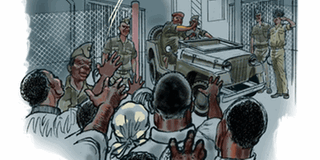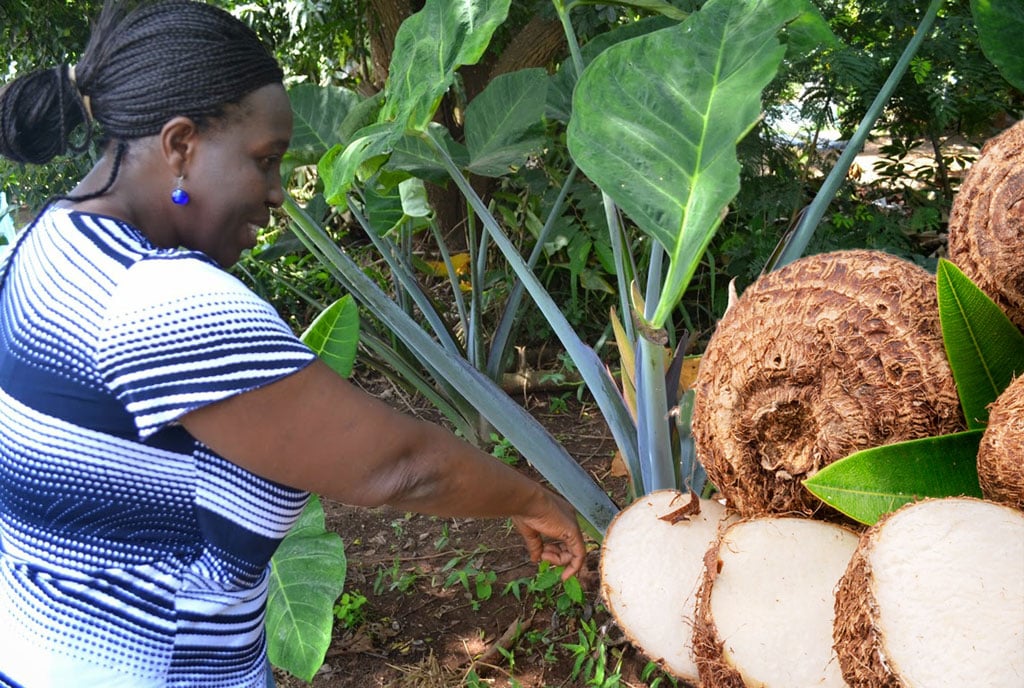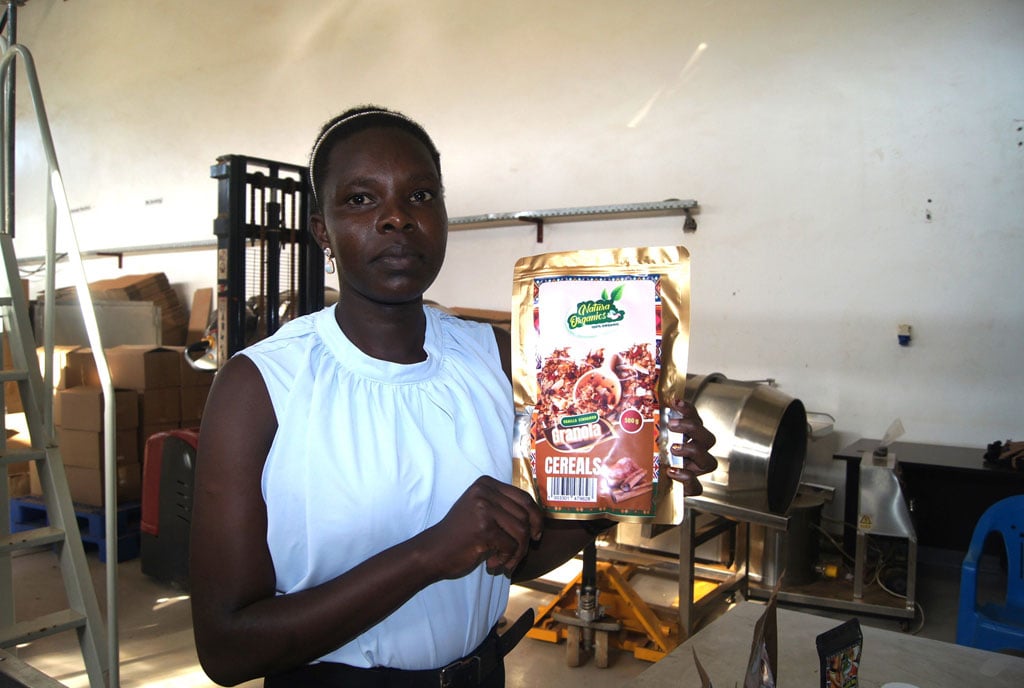Amin survives grenade attack at Nsambya Police Barracks

Narrow escape. Someone from the crowd throws a hand grenade at president Idi Amin’s jeep. ILLUSTRATION BY DANNY BARONGO
What you need to know:
- Final episode. To this day, no one has given a better account of how the would-be assassin was trained, from where and or how he penetrated the security ring at Nsambya Police Barracks.
When Idi Amin came to power after the January 1971 coup, there were celebrations across the country that lasted a week. There was an assumption that Amin would soon hand over power to a civilian who would perform better than the ousted Milton Obote.
But Ugandan’s would soon realise that Amin was going nowhere. This became even clearer after the November 1972 expulsion of Indians. Although some resigned to accepting him as president and saw him as a patriot, others didn’t want anything to do with him.
And this was demonstrated when an attempt was made on his life on June 10, 1976.
The plot is hatched
To this day, no one has given a better account of how the would-be assassin was trained, from where and or how he penetrated the security ring at Nsambya Police Barracks, now the CID Headquarters in Kampala.
President Amin had gone to Nsambya Police Barracks to officiate at the pass out of officer cadets. The evening function was hosted inside the now dilapidated halls adjacent to the Mukwano factory. Other dignitaries included then vice president, Gen Mustafa Adrisi, Cabinet ministers and senior government officials.
Amin arrived in a military jeep driven by Staff Sergeant Moses Abbas without any escort, as he often did. After the function ended at around 8pm, Amin bid farewell to the guests and took the steering wheel as his driver slid to the co-driver’s seat and they set off.
But as soon as they arrived at the barrack’s entrance, someone from the crowd that had gathered to wave to the president hurled a hand grenade at the jeep. The assassin was among the people standing on the left side of the gate.
It is said that when Amin reached the gate, he slowed down to wave back to the people who included women and children. The assassin then took advantage and threw the grenade on the co-driver’s seat, fatally injuring Abbas.
A shaken Amin then ordered soldiers to follow him as he sped off. It is said that Amin, holding the steering wheel with one arm and supporting Abbas with the other, sped off to Mulago hospital, about seven kilometres away. During the commotion that ensued, according to press reports, at least eight people were shot dead while about 20 sustained serious injuries.
Speaking to this reporter as his home in Jinja District recently, Henry Kyemba, who was minister of Health at the time and was also present at the function on that day, said: “I remember Amin had left us at the police main hall after the function as government ministers and other officials were going to their cars when we heard the explosion.”
“We panicked, but someone, I don’t remember who came and told us that Amin had been shot.”
Kyemba says he followed Amin to Mulago where he found the president standing by Abbas’s bedside as doctors attended to him.
Staff Sergeant Abbas died on June 14, 1976, at Mulago hospital. The following day, he was buried with military honour at the Kololo military cemetery.
While Amin was credited for having a good intelligence network, no one was arrested. No suspect was ever paraded before the public as was the norm during his regime. Although some authors have claimed that the Save Uganda Movement, a political group led by Baganda based in Nairobi, Kenya, was behind the attack.
Was CIA behind the plot?
Amin would later claim that America’s foreign intelligence service, the CIA, was behind the attempted assassination. He accused the CIA of recruiting Ugandan assassins disguised as pastors.
Speaking at a conference for governors and senior government officers hosted at the International Conference Centre (now Serena International Conference) on June 17, 1976, Amin warned that anyone caught dealing with the CIA would be executed by firing squad.
The president told the delegates that those behind his attempted assassination had been arrested. He also denied claims that he intended to rule Uganda for life as some people were saying. He, however, scorned those who thought they would get to power by assassinating him.
Obote survives assassination attempt
On December 19, 1969, then president Milton Obote survived death by a whisker. That evening, at around 9.30pm, Obote had just closed a two-day function at which UPC delegates had adopted the “Move to the Left” campaign. The function was held at the Lugogo Indoor Stadium in Kampala.
It was all smiles as guests saw off the president who walked from the hall towards his presidential car. But all of a sudden, there was a loud bang. A gun had been fired. Someone had just shot at president Obote.
Obote was about 15 yards from his car, followed by his aides, dignitaries and UPC delegates, amid cheers and dancing as the Uganda Army band played music when the would-be assassin, Mohamed Sebaduka, shot at the president.
Sebaduka, a renowned Muslim radical in Kampala, was armed with a semi-automatic Czech-made pistol as he stood behind a tree.
Sebaduka, dressed in a UPC Kitenge-shirt with Obote portraits, swiftly pulled the already corked pistol from his waist and aimed at Obote’s head. But instead of hitting the head, Sebaduka shot Obote in the cheek.
Obote was lucky. Had the pistol not jammed after the first shot was fired, Sebaduka would probably have fired more bullets at the president.
The single bullet hit the president’s right cheek and came out through the left cheek, forcing him to fall to the ground.
Obote’s Principle Private Secretary at the time, Henry Kyemba, who was with the president, too survived the bullet. The bullet that tore through Obote’s cheeks later hit Kyemba’s right shoulder.
“I remember the person who shot him was arrested by the security who wanted to kill him there and then. But I told them that we needed him alive to help us with information,” Kyemba told Sunday Monitor at his home in Jinja Town recently.
Obote was rushed to Mulago hospital where an operation was conducted by specialists. On December 24, 1969, Obote was discharged from hospital.
Assassin escapes
In the confusion that ensured after the shooting, Sebaduka escaped from his captors. But he was re-arrested within 12 hours.
Upon interrogation, he said former prime minister and president general of the Democratic Party, Benedicto Kiwanuka, was the mastermind of the assassination plot.




